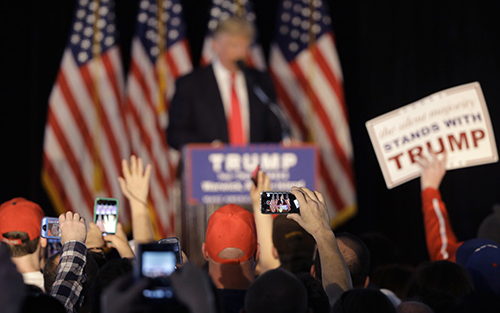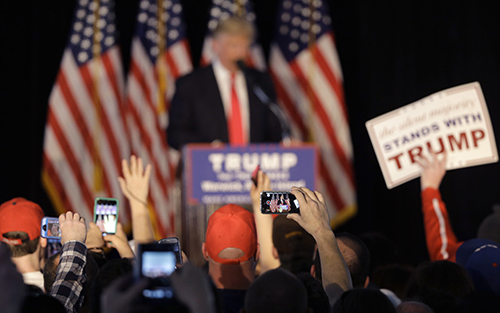As a new presidential administration prepares to take over the U.S., CPJ examines the status of press freedom, including the challenges journalists face from surveillance, harassment, limited transparency, the questioning of libel laws, and other factors.

Photos of gas chambers, profile pictures doctored on to images of Holocaust victims, death threats: these are just some of the disturbing and vitriolic content that conservative writer Bethany Mandel says she was deluged with every time she opened Twitter during the Republican primaries.
Mandel, who writes for Forward and The Federalist, estimates that at the height of the harassment she received about 30 to 40 tweets a day, but some days she would get 100, mostly from trolls angry at her refusal to support Donald Trump.
“It definitely took a toll, especially for the first couple of months,” Mandel told CPJ, adding that trolls had published her personal information online–a form of harassment known as doxing. Mandel said it was the level of harassment that finally pushed her to follow through on a decision to buy a gun. “I didn’t feel like anyone would come in my house but I was having nightmares and I thought that I would feel better if I had a gun–and I did,” she told CPJ.
Mandel isn’t the only journalist to take precautions after receiving death threats online. Former Fox News journalist Megyn Kelly has discussed travelling with security guards, another journalist said she turned off geolocation services on the social media platforms she uses, and several reported that they had to call the police because of the online harassment and death threats they receive.
While attacks have come from across the political spectrum, many reporters with whom CPJ spoke said that they felt that Trump has created an environment ripe for harassment. On Twitter alone, he tweeted 613 insults at reporters or media outlets between declaring his candidacy in June 2015 and December 6, according to a list compiled by The New York Times. This morning, President Trump took control of the @POTUS official Twitter account.
“He has, in effect, created an environment that is fostering incivility across the web and particularly against journalists who he has specifically targeted in his tweets and press conferences,” said Michelle Ferrier, a former journalist and founder of TrollBusters, a digital tool to combat online harassment.
The media and technology site Vocativ found a link between spikes in online harassment of Kelly and statements made on Twitter or television by Trump. The analysis of tweets directed at Kelly between March 2015 and March 2016, for instance, found the number of misogynistic tweets spiked after Trump insulted the then Fox News reporter on Twitter in August 2015 and again in January 2016. “Every time he tweeted about me, it was like he flipped a switch, instantly causing a flood of intense nastiness,” Kelly wrote in her book, Settle For More. The reporter said she hired a security guard for her family’s trip to Disney World because of the level of harassment.
In a separate study that analyzed tweets directed at 50,000 U.S. journalists between August 2015 and July 2016, the international Jewish nonprofit, Anti-Defamation League identified 19,253 anti-Semitic tweets sent to 800 journalists, 68 percent of which came from 1,600 accounts. The words that showed up the most in the bios of the accounts’ users were “Trump,” “nationalist,” “conservative,” “American,” and “white.”
“This finding does not imply that Mr. Trump supported these tweets, or that conservatives are more prone to anti-Semitism. It does show that the individuals directing anti-Semitism toward journalists self-identified as Trump supporters and conservatives,” the report, published in October, said.
Jonah Goldberg, senior editor for National Review who the Anti-Defamation League report found was among the top 10 journalists targeted by anti-Semitic tweets, told CPJ, “In his heart, I don’t think Trump likes virulent anti-Semites saying anti-Semitic things on his behalf, but he has some responsibility in the sense that his whole campaign style was to grab the nearest weapon at hand and use it mercilessly. There was a whole glorification of counterpunching as a good in itself, and it contributed to a climate that he has some responsibility for. He definitely played this sort of dog whistle game.”
Trump has been slow to publicly condemn the behavior of those identifying themselves as his supporters. When Wolf Blitzer questioned him on CNN in May about anti-Semitic death threats sent, allegedly by his supporters, to the freelance reporter Julia Ioffe, Trump said, “I don’t have a message to the fans.” After he was elected, Trump told Lesley Stahl on “60 Minutes” that he was not aware of racial slurs and attacks allegedly coming from his supporters. When asked if he had a message to those engaging in such harassment, Trump said, “I am so saddened to hear that. And I say, ‘Stop it.’ If it–if it helps. I will say this, and I will say right to the cameras: ‘Stop it’.”
Trump’s transition team did not respond to CPJ’s emailed request for comment about the hostility that journalists say they have experienced. It is unclear if his tone will change on social media now he has been sworn in as president.
Jane Eisner, editor-in-chief of Forward, told CPJ, she is concerned about the impact Trump’s rhetoric can have. “I don’t want to say the Trump campaign is responsible [for the harassment], but in my view they are responsible for the cause and effect. And they have been irresponsible in not condemning it.” She added, “It’s not just disappointing to me, it’s really irresponsible.”
The journalists with whom CPJ spoke were quick to point out that they are public figures who should, and do, expect criticism, and that there can even be a role for politicians to criticize the media. “As a conservative of good standing for a very long time, I definitely think that Republicans get worse treatment from the press than Democrats do, and when George H.W. Bush took on Dan Rather, there was merit to Bush’s position. I think that there is room for pushback against the press,” Goldberg told CPJ.
But Goldberg drew a line between constructive debate and attempts to retaliate against critical journalists. “When Trump is at a rally during the campaign and calls out MSNBC reporters by name and talks about how terrible they are with a whole crowd screaming at them–forget the ideological argument–it’s just ungentlemanly, irresponsible, caddish behavior,” he said. “I think it’s a really, really ugly environment for the press.”
Some journalists told CPJ that while they have grown accustomed to online harassment, such behavior does interfere with how they would like to use social media in their work.
“I’ve turned off notifications on my Twitter from people who I don’t follow, so if people are sending me nasty stuff I just don’t see it, and if strangers send me nice things either,” Amanda Hess, a New York Times David Carr fellow, told CPJ. Hess said that despite taking such precautions to deal with online trolls over the years, she still faces harassment. “I just heard from my mom the other day, and I’m not sure how someone found her because she doesn’t have my name, but someone was upset with something I wrote and tracked her down and was hassling her. That really bothered me. They know how to exploit your networks and target your family,” she said.
The constant onslaught of hate mail, which often focuses on the gender, race, religion, or ethnicity of journalists can take a psychological and emotional toll.
“I remember being initially just depressed about it. I wasn’t taking it personally or anything like that. I mean depressed in the sense of like it makes you feel sad about humanity. It affected my sense of optimism that the majority of people are good,” Sally Kohn, a political commentator for CNN said.
The reporters said they sometimes felt uneasy knowing they would be trolled. “There have been times when I’ve written certain stories and I kind of braced myself for the onslaught,” Melanie Eversley, a reporter for USAToday who writes about race issues and civil rights, told CPJ.
In some cases, the level of abuse has forced journalists and writers to quit Twitter or take legal action. Jonathan Weisman of The New York Times briefly quit Twitter in June 2016 over anti-Semitic trolling and the feminist author Jessica Valenti took a several-months hiatus after she received rape threats against her five-year-old daughter, according to reports. Kurt Eichenwald, a senior writer for Newsweek who has written publicly about having epilepsy, said on Twitter last month that he is filing charges after an online troll triggered a seizure by sending him a graphic with flashing lights.
Kohn, who appeared on the Anti-Defamation League list of targeted journalists, told CPJ, “I used to find Twitter to be really a constructive space for engaging in critics and criticism and would have really nice back and forth with people who had legitimate points I disagreed with. Maybe those people are still on Twitter. I don’t know. I don’t see them as much because so much of my feed has become overwhelmed with just nasty, vitriolic trolling.”
Many of the journalists with whom CPJ spoke said that more research was needed to identify where the trolls were coming from–whether they were real people, bots or paid trolls based abroad. David Lazer, a professor of political science and computer and information science at Northeastern University, told CPJ he is working on a project to trace the evolution of online attacks against the press. “Media is one of the key institutions protecting society, but we see that individual reporters are vastly more exposed now on social media,” he said. “I see journalists as being on the front lines.”
Daniel Bedoya Arrayo, an incident response manager for digital rights group Access Now, said that improving online digital safety could limit the consequences of harassment. This is especially important given the practice of doxing journalists.
Bedoya recommended journalists secure online accounts, review public information linked to their names in online searches, properly manage passwords and use two-factor authentication. He added that journalists should be on the lookout for social engineering attacks and phishing attempts.
Additional tips, including how to prevent personal information appearing on website domain registrations can be found in article by the Reporters Committee for Freedom of the Press on Poynter, the online publication of the Poynter Institute’s journalism school.
